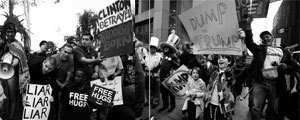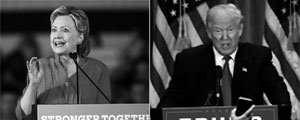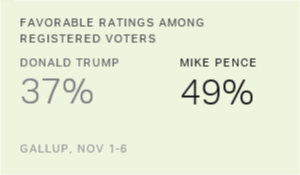One in four Americans have an unfavorable opinion of both Donald Trump and Hillary Clinton, more than double the rate who disliked both candidates in 2012 and about four times higher than in 2008. This high level of joint unpopularity could foreshadow low voter turnout or the rise of a third-party candidate, but there are reasons why these outcomes are by no means sure things at this point.
Overall, 35% of U.S. adults interviewed over the course of June had a favorable view of the former secretary of state but an unfavorable view of Trump. (These results, it should be noted, are based on Gallup's binary favorable/unfavorable measure, different from Gallup's historical "scalometer," the results of which have been analyzed by our colleague Lydia Saad here and which will be discussed below.) Another 28% liked Trump but disliked Clinton. In contrast to the 25% who dislike both candidates, 4% hold positive images of both candidates.
| Opinion of Trump | Opinion of Clinton | % of U.S. adults holding these opinions | |||||||||||||||||||||||||||||||||||||||||||||||||||||||||||||||||||||||||||||||||||||||||||||||||
|---|---|---|---|---|---|---|---|---|---|---|---|---|---|---|---|---|---|---|---|---|---|---|---|---|---|---|---|---|---|---|---|---|---|---|---|---|---|---|---|---|---|---|---|---|---|---|---|---|---|---|---|---|---|---|---|---|---|---|---|---|---|---|---|---|---|---|---|---|---|---|---|---|---|---|---|---|---|---|---|---|---|---|---|---|---|---|---|---|---|---|---|---|---|---|---|---|---|---|---|
| Unfavorable | Favorable | 35 | |||||||||||||||||||||||||||||||||||||||||||||||||||||||||||||||||||||||||||||||||||||||||||||||||
| Favorable | Unfavorable | 28 | |||||||||||||||||||||||||||||||||||||||||||||||||||||||||||||||||||||||||||||||||||||||||||||||||
| Unfavorable | Unfavorable | 25 | |||||||||||||||||||||||||||||||||||||||||||||||||||||||||||||||||||||||||||||||||||||||||||||||||
| Favorable | Favorable | 4 | |||||||||||||||||||||||||||||||||||||||||||||||||||||||||||||||||||||||||||||||||||||||||||||||||
| Note: Table omits percentage of adults with no opinion of either candidate. | |||||||||||||||||||||||||||||||||||||||||||||||||||||||||||||||||||||||||||||||||||||||||||||||||||
| Gallup Daily tracking June 1-30, 2016 | |||||||||||||||||||||||||||||||||||||||||||||||||||||||||||||||||||||||||||||||||||||||||||||||||||
So who are the "25%" who don't like either of the candidates this year? One defining feature: 54% describe themselves as politically independent. Although many of these independents actually lean to one party or the other, as a group they have less attachment to the system and are less likely to vote, raising the possibility that those who dislike both candidates also have a lower probability of actually voting.
The 25% who dislike both candidates are also disproportionately young. This could, in part, reflect the lasting allure of Democratic candidate Bernie Sanders for this group. Throughout June, when these data were collected, Sanders had still not formally conceded to Clinton. It's possible that this group will grow more positive about Clinton after she is officially crowned as the Democratic nominee. But, in general, young people are less valuable as voters because they have the lowest turnout rates of any age group. This, in turn, underscores a possible conclusion that the high unpopularity of the two candidates may have less impact on the election than might be initially thought -- because the joint unpopularity is centered in demographic groups who are the least likely to vote in any circumstance.
Americans who dislike both candidates are about evenly split on whether they approve of Barack Obama's job as president -- 46% approve and 50% disapprove, compared with his overall 52%/44% rating from the U.S. public in the month of June.
| Total population | Favorable Clinton, unfavorable Trump | Unfavorable Clinton and unfavorable Trump | Favorable Trump, unfavorable Clinton | ||||||||||||||||||||||||||||||||||||||||||||||||||||||||||||||||||||||||||||||||||||||||||||||||
|---|---|---|---|---|---|---|---|---|---|---|---|---|---|---|---|---|---|---|---|---|---|---|---|---|---|---|---|---|---|---|---|---|---|---|---|---|---|---|---|---|---|---|---|---|---|---|---|---|---|---|---|---|---|---|---|---|---|---|---|---|---|---|---|---|---|---|---|---|---|---|---|---|---|---|---|---|---|---|---|---|---|---|---|---|---|---|---|---|---|---|---|---|---|---|---|---|---|---|---|
| % | % | % | % | ||||||||||||||||||||||||||||||||||||||||||||||||||||||||||||||||||||||||||||||||||||||||||||||||
| All | 100 | 35 | 25 | 28 | |||||||||||||||||||||||||||||||||||||||||||||||||||||||||||||||||||||||||||||||||||||||||||||||
| Republican | 26 | 4 | 24 | 61 | |||||||||||||||||||||||||||||||||||||||||||||||||||||||||||||||||||||||||||||||||||||||||||||||
| Independent | 40 | 30 | 54 | 33 | |||||||||||||||||||||||||||||||||||||||||||||||||||||||||||||||||||||||||||||||||||||||||||||||
| Democrat | 30 | 62 | 20 | 4 | |||||||||||||||||||||||||||||||||||||||||||||||||||||||||||||||||||||||||||||||||||||||||||||||
| 18-29 | 21 | 17 | 34 | 13 | |||||||||||||||||||||||||||||||||||||||||||||||||||||||||||||||||||||||||||||||||||||||||||||||
| 30-49 | 33 | 35 | 33 | 29 | |||||||||||||||||||||||||||||||||||||||||||||||||||||||||||||||||||||||||||||||||||||||||||||||
| 50-64 | 26 | 28 | 20 | 32 | |||||||||||||||||||||||||||||||||||||||||||||||||||||||||||||||||||||||||||||||||||||||||||||||
| 65+ | 20 | 20 | 13 | 27 | |||||||||||||||||||||||||||||||||||||||||||||||||||||||||||||||||||||||||||||||||||||||||||||||
| White | 67 | 50 | 73 | 90 | |||||||||||||||||||||||||||||||||||||||||||||||||||||||||||||||||||||||||||||||||||||||||||||||
| Nonwhite | 31 | 48 | 25 | 8 | |||||||||||||||||||||||||||||||||||||||||||||||||||||||||||||||||||||||||||||||||||||||||||||||
| Highly religious | 38 | 33 | 36 | 45 | |||||||||||||||||||||||||||||||||||||||||||||||||||||||||||||||||||||||||||||||||||||||||||||||
| Moderately religious | 30 | 32 | 25 | 31 | |||||||||||||||||||||||||||||||||||||||||||||||||||||||||||||||||||||||||||||||||||||||||||||||
| Not religious | 33 | 36 | 39 | 24 | |||||||||||||||||||||||||||||||||||||||||||||||||||||||||||||||||||||||||||||||||||||||||||||||
| Approve Obama job | 52 | 90 | 46 | 6 | |||||||||||||||||||||||||||||||||||||||||||||||||||||||||||||||||||||||||||||||||||||||||||||||
| Disapprove Obama job | 44 | 8 | 50 | 93 | |||||||||||||||||||||||||||||||||||||||||||||||||||||||||||||||||||||||||||||||||||||||||||||||
| Gallup Daily tracking June 1-30, 2016 | |||||||||||||||||||||||||||||||||||||||||||||||||||||||||||||||||||||||||||||||||||||||||||||||||||
Gallup's historical "scalometer" uses a 10-point scale (measured from -5 to +5), which allows Americans to register to what degree they have a favorable or unfavorable view of the candidates. Gallup considers scores of -4 or -5 to represent a very unfavorable view of the candidate. Recent analysis by Gallup colleague Lydia Saad shows that both Trump's and Clinton's highly unfavorable ratings are, in fact, the highest in Gallup's history of evaluating presidential nominees on this scale. Despite these generally high levels of unpopularity using the scalometer, only 4% of the country has a very unfavorable view of both candidates, indicating that even among those who dislike both candidates, one candidate is more strongly disliked than the other.
Prior to this year's election, Barry Goldwater was the most unpopular candidate Gallup measured. Goldwater lost the 1964 election by a "landslide" -- Lyndon Johnson had 61% of the popular vote and Goldwater had 38%.
What is the potential impact of the record unpopularity of the candidates on the 2016 election? One obvious consequence could be lower voter turnout, although as discussed previously, those who are negative about both candidates tend to be those who are less likely to vote in general. Several other factors cast some doubt on the prediction of a lower turnout this year. For one, the GOP primaries this year saw unusually high turnout, and Gallup has found about the same percentage of adults are paying attention to this election as the last two elections.
Another possibility: The high unpopularity of the two major-party candidates will open the door for a third-party candidate to gain traction. With the Libertarian Party boasting that it is working to feature its presidential ticket on the ballot in all 50 states for the first time in party history, Libertarian candidate Gary Johnson, in particular, could stand to benefit. Gallup has found for the last several years that a majority of Americans believe a third-party candidate is needed.
The last serious (in an electoral sense) third-party candidate was Ross Perot, who ran against Bill Clinton and incumbent George H.W. Bush -- both of whom, at times, struggled with their own popularity. Perot's respectable performance in that election -- he received 19% of the popular vote, though he won no electoral votes -- might bode well for Johnson. But it is worth noting that Perot was a self-funded billionaire who was able to finance a national campaign -- something no third-party candidate on the horizon, save a Michael Bloomberg who has said he will not run, seems capable of doing.




